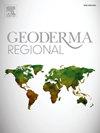Mapping basic properties of Danish sandy soils using on-the-go proximal sensors and terrain attributes
IF 3.3
2区 农林科学
Q2 SOIL SCIENCE
引用次数: 0
Abstract
On-the-go proximal soil sensing based on geophysical sensors is increasingly recognized as the ‘gold standard’ in digital soil mapping due to its capacity to generate high-resolution maps of soil properties at the field scale. However, studies of their limitations are scarce. In this study, we evaluated the suitability of electromagnetic induction (EMI) and gamma-ray spectroscopy (GRS), along with terrain attributes (TA), to predict four soil properties, i.e. clay content, total carbon, bulk density, and soil water content. Soil samples were collected from the top (15 cm depth) and subsoil (40 cm depth) at 69 points distributed in three sandy arable fields. Soil properties were estimated through multiple linear regression (MLR) and cross-validated using the Leave-One-Out Cross-Validation (LOOCV). The MLR models were then filtered based on Lin's concordance correlation coefficient (LCCC), coefficient of determination (R2) and normalized root mean square error (nRMSE). The results indicated that estimating the soil properties in sandy soils is challenging, specifically in subsoil, as reliable models were achieved only for topsoil in two fields. Inverting the EMI data improved modelling results compared to using raw EMI data. Despite the challenges encountered, predictors from the EMI and GRS emerged as key contributors to models with the highest performance, indicating the potential of on-the-go geophysical sensors for generating high-resolution digital soil maps.
利用近端传感器和地形属性绘制丹麦沙土的基本属性
基于地球物理传感器的即时近端土壤遥感越来越被认为是数字土壤制图的“黄金标准”,因为它能够在野外尺度上生成高分辨率的土壤属性地图。然而,对其局限性的研究很少。在这项研究中,我们评估了电磁感应(EMI)和伽马射线能谱(GRS)以及地形属性(TA)在预测粘土含量、总碳含量、容重和土壤含水量等四种土壤性质中的适用性。在3个沙质耕地中分别从表层(15 cm)和下层(40 cm)的69个点采集土壤样品。通过多元线性回归(MLR)估计土壤性质,并使用留一交叉验证(LOOCV)进行交叉验证。然后根据Lin’s一致性相关系数(LCCC)、决定系数(R2)和归一化均方根误差(nRMSE)对MLR模型进行滤波。结果表明,估计沙质土壤的土壤性质是具有挑战性的,特别是在底土中,因为在两个领域中只获得了表土的可靠模型。与使用原始电磁干扰数据相比,反演电磁干扰数据改善了建模结果。尽管遇到了挑战,但EMI和GRS的预测器成为了性能最高的模型的关键贡献者,这表明了移动地球物理传感器在生成高分辨率数字土壤地图方面的潜力。
本文章由计算机程序翻译,如有差异,请以英文原文为准。
求助全文
约1分钟内获得全文
求助全文
来源期刊

Geoderma Regional
Agricultural and Biological Sciences-Soil Science
CiteScore
6.10
自引率
7.30%
发文量
122
审稿时长
76 days
期刊介绍:
Global issues require studies and solutions on national and regional levels. Geoderma Regional focuses on studies that increase understanding and advance our scientific knowledge of soils in all regions of the world. The journal embraces every aspect of soil science and welcomes reviews of regional progress.
 求助内容:
求助内容: 应助结果提醒方式:
应助结果提醒方式:


